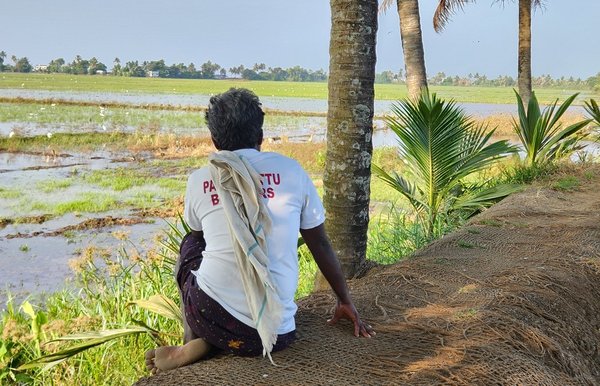- Share this article
- Subscribe to our newsletter
Floods endangering below sea-level heritage farming system in India
In 2013, the site was declared a Globally Important Agricultural Heritage System (GIAHS) by the Food and Agriculture Organization (FAO). In order to safeguard and support the world’s agri-cultural heritage systems, the FAO started an initiative in 2002 for the active conservation of such GIAHS sites.
Farmers in Kuttanad have been able to do below seal-level farming for decades by raising bunds made of locally available material rather than concrete. Bunds have traditionally been raised by using coconut co-products along with sand, twigs and high quality clay– they are periodically strengthened to withstand the pressure of floodwaters. Field committees, also called Padasekhara, and made up of farmers in their respective areas, carry out the maintenance work of the bunds, and the costs are shared by all the farmers.
‘Man created Kuttanad’
K. G. Padmakumar, director of the Kuttanad-based International Research and Training Centre for Below Sea Level Farming (IRTCBSF), maintains that the farming system in Kuttanad is unique. “It was because of the sheer hard work and community knowledge of the farmers that this unique farming system below the sea-level took birth over 200 years ago,” Padmakumar says, quoting a famous local saying: “God created Kerala and man created Kuttanad.”
According to Kerala’s Tourism Department, the indigenous techniques developed by the farmers of Kuttanad have several similarities with the Dutch Polder system. “But the concrete bunds used in the Netherlands were substituted here with bio-bunds made of coir, banana waste, bamboo, clay and other locally available materials to keep away the saline seawater,” says a note on Kuttanad’s heritage farming on the tourism department’s website.
Once the bund is constructed, the farmers dewater the polder area by pumping it out using oil engines or electric motors – earlier, dewatering used to be done manually with the help of large waterwheels. The process of rice cultivation commences immediately after dewatering of the polder area has been completed.
Cultivation of rice, which contributes 25 per cent of the rice production in Kerala, and fish farming are the major land and water use practices of Kuttanad’s polder system, the largest wetland use system on the west coast of Indian peninsula. The system also allows duck farming in a promising way. Immediately after harvesting the rice, ducks, coming even from distant places, are brought into the fields, ensuring a direct food and manure supply for the farmers, but also a source of income.
Some experts, including Padmakumar, say that Kuttanad’s farming system “serves as a model for developing farming techniques to checkmate the adverse impact of sea-level rise and also helps to prevent the proliferation of climate refugees”. The system of below sea-level farming, experts maintain, is an approach to cope with the imminent climate impacts in coastal areas and evolve efficient methods to deal with soil and pest-related issues in agriculture.
A heritage threatened by floods
Hailed as the pride of agricultural practices in Kerala, farmers now say that Kuttanad’s heritage farming is at risk as they have to constantly work on bunds to prevent flooding of their farms.
According to Padmakumar from IRTCBSF, farming in the region is now somewhat like "a gamble with nature”. He says that farmers are not sure about the harvests they get from the crops as the threat of flooding always looms. Floods have occurred in three out of the last five years, and damaged crops especially in 2018 he notes. Padmakumar maintains that the principal reason for the large-scale flood damage in Kuttanad may not be directly related to any point source, adding that “rather, it is a mixture of anthropogenic activities and the natural processes”.
For Vishyakan, a farmer in Kuttanad, frequent flooding is not only a constant worry for his paddy crop “almost every year”, but also a problem for his coconut trees. Some of Vishyakan’s trees are dead, having been inundated with water for too long.
“Our area remains submerged for weeks during floods which occur almost every year. During rains, the outer bounds of the paddy fields suffer breaches, and our crops get damaged,” he laments, adding that this has become a source of frustration for farmers. Thousands of people have migrated from Kuttanad, especially after the 2018 devastating floods, Vishyakan explains that Kuttanad once used to attract farmers from other areas, but that now people are leaving. According to official figures, over 6,000 people have migrated from Kuttanad in the past three years.
“Most of the people migrated because they were fed up with their houses frequently being submerged in water,” says Rakhavan, another farmer in Kuttanad. “But when they visit us here or we meet them somewhere, we can make it out that they miss this area. This is where we have lived our lives. It is very difficult to think of leaving this place despite the fact that the fear of flooding always plays on our minds.”
Rakhavan and most of the other farmers have heard about climate change, and they attribute frequent flooding to it. “This place used to get flooded in the past as well. It is not as if floods were occurring right now. But floods now strike our region more often than in the past,” Rakhavan explains.
Padmakumar from IRTCBSF maintains that Kuttanad is a victim of both natural processes such floods and droughts as well as also misplaced and impractical developmental schemes. “There is an urgent need to evolve strategies that can support lives and livelihoods in low-lying Kuttanad,” Padmakumar says, adding that there is a need to find new solutions, as raising dikes or barrages does not seem to support effective protection of people or property any longer.
Athar Parvaiz is a freelance journalist based in Srinagar/ Kashmir, India. Contact: atharparvaiz.ami(at)gmail.com
More information:
Globally Important Agricultural Heritage System (GIAHS)
International Research and Training Centre for below Sea Level Farming, Kuttanad (IRTCBSF)





Add a comment
Be the First to Comment